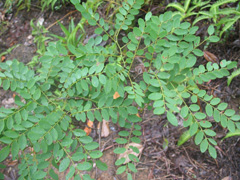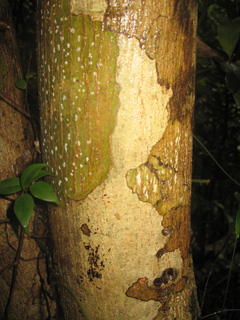 |
|
https://edibleplants.org/ |
 |
| https://edibleplants.org/ |
Translate this page:
Summary
Dalbergia louvelii is a deciduous tree about 20 m in height found in Africa specifically in eastern Madagascar. It produces valuable rosewood for export but due to overexploitation, it has been classified as an endangered species. It has a symbiotic relationship with certain soil bacteria that form nodules on the roots and fix atmospheric nitrogen. The heartwood is used in the treatment of bilharzia and malaria. It is very heavy and very hard and preferred in making cabinets, furniture, marquetry, and parquet flooring. It is also used in musical instrument, carvings, turnings, and for tombs.
Physical Characteristics

 Dalbergia louvelii is a deciduous Tree growing to 15 m (49ft) by 15 m (49ft) at a medium rate.
Dalbergia louvelii is a deciduous Tree growing to 15 m (49ft) by 15 m (49ft) at a medium rate.
See above for USDA hardiness. It is hardy to UK zone 10. The flowers are pollinated by Insects.
It can fix Nitrogen.
Suitable for: light (sandy), medium (loamy) and heavy (clay) soils and prefers well-drained soil. Suitable pH: mildly acid and neutral soils. It cannot grow in the shade. It prefers moist soil.
UK Hardiness Map
US Hardiness Map
Synonyms
Plant Habitats
Edible Uses
References More on Edible Uses
Medicinal Uses
Plants For A Future can not take any responsibility for any adverse effects from the use of plants. Always seek advice from a professional before using a plant medicinally.
Malaria Parasiticide
The heartwood is used in traditional medicine to treat bilharzia and malaria[ 299 ]. Several flavonoids have been isolated from the heartwood, some of which showed antiplasmodial activity[ 299 ].
References More on Medicinal Uses
The Bookshop: Edible Plant Books
Our Latest books on Perennial Plants For Food Forests and Permaculture Gardens in paperback or digital formats.

Edible Tropical Plants
Food Forest Plants for Hotter Conditions: 250+ Plants For Tropical Food Forests & Permaculture Gardens.
More

Edible Temperate Plants
Plants for Your Food Forest: 500 Plants for Temperate Food Forests & Permaculture Gardens.
More

More Books
PFAF have eight books available in paperback and digital formats. Browse the shop for more information.
Shop Now
Other Uses
Furniture Parasiticide Wood
Other Uses: The heartwood is purplish red, becoming purplish black upon drying. The texture is fine and even, and the wood has a beautiful polish. It is very heavy and very hard. The wood is much in demand for cabinet making, furniture, marquetry and parquet flooring. It is one of the favoured woods for musical instruments and is locally in high demand for carving and turning. It has been used traditionally for tombs[ 299 ].
Special Uses
Nitrogen Fixer
References More on Other Uses
Cultivation details
This species has a symbiotic relationship with certain soil bacteria, these bacteria form nodules on the roots and fix atmospheric nitrogen. Some of this nitrogen is utilized by the growing plant but some can also be used by other plants growing nearby[ 299 ].
References Carbon Farming Information and Carbon Sequestration Information
Temperature Converter
Type a value in the Celsius field to convert the value to Fahrenheit:
Fahrenheit:
The PFAF Bookshop
Plants For A Future have a number of books available in paperback and digital form. Book titles include Edible Plants, Edible Perennials, Edible Trees,Edible Shrubs, Woodland Gardening, and Temperate Food Forest Plants. Our new book is Food Forest Plants For Hotter Conditions (Tropical and Sub-Tropical).
Shop Now
Plant Propagation
Like many species within the family Fabaceae, once they have been dried for storage the seeds of this species may benefit from scarification before sowing in order to speed up germination. This can usually be done by pouring a small amount of nearly boiling water on the seeds (being careful not to cook them!) and then soaking them for 12 - 24 hours in warm water. By this time they should have imbibed moisture and swollen - if they have not, then carefully make a nick in the seedcoat (being careful not to damage the embryo) and soak for a further 12 hours before sowing[ K ].
Other Names
If available other names are mentioned here
Volombodipona à grandes feuilles - French, andramena - Malagasy, hendramena - Malagasy, volombodipona - Malagasy, volombodipona vavy - Malagasy, madagaskisk violpalisander - Swedish.
Native Range
AFRICA: Madagascar (east)
Weed Potential
Right plant wrong place. We are currently updating this section.
Please note that a plant may be invasive in one area but may not in your area so it's worth checking.
Conservation Status
IUCN Red List of Threatened Plants Status : Status: Endangered A1cd+2cd

| Related Plants
|
| Latin Name | Common Name | Habit | Height | Hardiness | Growth | Soil | Shade | Moisture | Edible | Medicinal | Other |
| Dalbergia baronii | Palissandre rouge des marais, hitsika, sovodrano | Tree | 20.0 |
10-12
| M | LM | N | Mwe | 0 | 0 | 4 |
| Dalbergia cochinchinensis | Siam Rosewood, Thailand Rosewood | Tree | 25.0 |
10-12
| S | LMH | N | M | 0 | 0 | 4 |
| Dalbergia greveana | Madagascar Rosewood | Tree | 15.0 |
10-12
| S | LMH | N | DM | 0 | 2 | 4 |
| Dalbergia hupeana | | Tree | 15.0 |
-
| | LMH | SN | M | 1 | 1 | 3 |
| Dalbergia latifolia | Black Rosewood, East Indian Rosewood, Kala sheeshan, Satisal | Tree | 30.0 |
10-12
| M | LMH | N | M | 0 | 2 | 4 |
| Dalbergia melanoxylon | African Blackwood, Grenadilla, Mpingo | Tree | 6.0 |
10-12
| S | LMH | N | DM | 0 | 2 | 5 |
| Dalbergia monticola | Hazovola, tsiandalana, voamboana | Tree | 12.0 |
10-12
| S | LMH | N | M | 0 | 0 | 4 |
| Dalbergia nigra | Brazilian Rosewood | Tree | 20.0 |
10-12
| M | LMH | N | DM | 0 | 0 | 4 |
| Dalbergia oliveri | Redwood | Tree | 23.0 |
10-12
| S | LMH | SN | M | 0 | 0 | 4 |
| Dalbergia retusa | Cocobolo | Tree | 20.0 |
10-12
| S | LMH | N | M | 0 | 0 | 4 |
| Dalbergia stevensonii | Honduras Rosewood | Tree | 20.0 |
10-12
| S | LMH | N | M | 0 | 0 | 4 |
|
Growth: S = slow M = medium F = fast. Soil: L = light (sandy) M = medium H = heavy (clay). pH: A = acid N = neutral B = basic (alkaline). Shade: F = full shade S = semi-shade N = no shade. Moisture: D = dry M = Moist We = wet Wa = water.
Now available:
Food Forest Plants for Mediterranean Conditions
350+ Perennial Plants For Mediterranean and Drier Food Forests and Permaculture Gardens.
[Paperback and eBook]
This is the third in Plants For A Future's series of plant guides for food forests tailored to
specific climate zones. Following volumes on temperate and tropical ecosystems, this book focuses
on species suited to Mediterranean conditions—regions with hot, dry summers and cool, wet winters,
often facing the added challenge of climate change.
Read More
Expert comment
Author
R.Vig.
Botanical References
Links / References
For a list of references used on this page please go here
A special thanks to Ken Fern for some of the information used on this page.
Readers comment
| Add a comment |
|
If you have important information about this plant that may help other users please add a comment or link below. Only comments or links that are felt to be directly relevant to a plant will be included. If you think a comment/link or information contained on this page is inaccurate or misleading we would welcome your feedback at [email protected]. If you have questions about a plant please use the Forum on this website as we do not have the resources to answer questions ourselves.
* Please note: the comments by website users are not necessarily those held by PFAF and may give misleading or inaccurate information.
To leave a comment please Register or login here All comments need to be approved so will not appear immediately.
|
Subject : Dalbergia louvelii
|
|
|
|